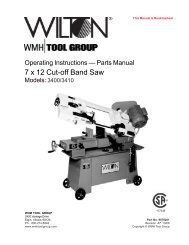This Rigger's Handbook is dedicated to Theodore C - Igor Chudov
This Rigger's Handbook is dedicated to Theodore C - Igor Chudov
This Rigger's Handbook is dedicated to Theodore C - Igor Chudov
Create successful ePaper yourself
Turn your PDF publications into a flip-book with our unique Google optimized e-Paper software.
YOUR SLING AND RIGGING SPECIALIST<br />
5.4 - INSPECTION<br />
HEADQUARTERS: 55 James E. Casey Drive • Buffalo, NY 14206 PHONE: 716.826.2636 FAX: 716.826.4412 www.hanessupply.com<br />
57<br />
Nylon Web Slings<br />
5.4.1 TYPE OF INSPECTION<br />
a. INITIAL INSPECTION – Before any new or repaired sling <strong>is</strong> placed in service, it shall<br />
be inspected <strong>to</strong> insure that the correct sling <strong>is</strong> being used, as well as <strong>to</strong> determine that<br />
the sling meets the requirements of th<strong>is</strong> specification.<br />
b. FREQUENT INSPECTION – <strong>Th<strong>is</strong></strong> inspection should be made by the person handling the<br />
sling each time the sling <strong>is</strong> used.<br />
c. PERIODIC INSPECTION – <strong>Th<strong>is</strong></strong> inspection shall be conducted by designated personnel.<br />
Frequency of inspection should be based on:<br />
1. Frequency of sling use<br />
2. Severity of service conditions<br />
3. Experience gained on the service life of slings used in similar applications<br />
4. Periodic inspections should be conducted at least monthly<br />
5.5 - POSSIBLE DEFECTS<br />
5.5.1 A sling shall be removed from service if any defects such as the following are v<strong>is</strong>ible:<br />
a. Acid or alkali burns<br />
b. Melting, charring, or weld spatter of any part of the sling<br />
c. Holes, tears, cuts, snags or embedded particles<br />
d. Broken or worn stitching in load bearing splices<br />
e. Excessive abrasive wear<br />
f. Knots in any part of the sling<br />
g. D<strong>is</strong><strong>to</strong>rtion and excessive pitting or corrosion or broken fittings<br />
h. Other apparent defects which cause doubt as <strong>to</strong> the strength of the sling<br />
i. If sling rated capacity or sling material identification <strong>is</strong> m<strong>is</strong>sing or not readable<br />
5.6 - INSPECTION RECORDS<br />
5.6.1 Written inspection records, utilizing the identification for each sling as establ<strong>is</strong>hed by<br />
the user, should be kept on file for all slings. These records should show a description<br />
of the new sling and its condition on each subsequent inspection.<br />
5.7 - REPAIR OF WEB SLINGS<br />
5.7.1 Slings shall be repaired only by a sling manufacturer. When repaired by other than the<br />
original manufacturer, the sling shall be permanently marked <strong>to</strong> identify the repair<br />
agent.<br />
5.7.2 All repaired slings shall be proof-tested <strong>to</strong> two (2) times its newly assigned rated<br />
capacity, berfore being put back in<strong>to</strong> service. Certification of proof-test should be<br />
provided.<br />
5.7.3 Temporary repairs of either webbing, fittings, or stitching shall not be permitted.
















